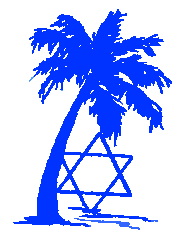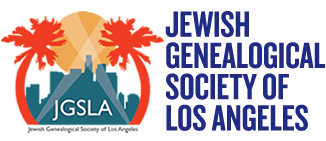March 2006
 |
JGSLA DATES AND UPDATESJEWISH GENEALOGICAL SOCIETY of LOS ANGELES March 2006 |
| • Program for Monday, March 20, 2006 • | |
|
7:00 p. m. Pre-Meeting: “Yizkor Books – Bridges to the Past” Yizkor books are memorial books that recollect Eastern European Jewish communities, primarily created by landsmanshaftn (societies of immigrants from the same town) after the Holocaust, and were written in Hebrew or Yiddish. They are useful for genealogists because they contain family names and specific information on your ancestors who were living in Eastern Europe during the interwar years. JewishGen’s Yizkor Book Project posted its first translation in 1997 and at the end of 2005 it had 677 entries in 416 books. Currently there are translations from volumes on Hungary, Latvia, Lithuania, Poland, Romania, Slovakia, and Yugoslavia. Providing yizkor books online gives us the opportunity to create a bridge from the past to the present and on to the future. Joyce Field will explain how JewishGen’s Yizkor Book project functions, what insights can be gained from researching these memorial books, and how you can help in the effort to make additional translations available to all researchers. Speaker: Joyce Field has been actively involved in Jewish genealogy for 10 years and with JewishGen since 1997, when she assumed the role of Yizkor Book Translations Manager. Joyce became JewishGen Vice President of Research in August 1999, was instrumental in creating the Jewish Online Worldwide Burial Register. She is also a Vice-President for Data Acquisition for JewishGen. 7:30 p. m. Main Program: “Genealogical Research at the American Jewish Historical Archives in Cincinnati: Unusual Resources” The Jacob Rader Marcus Center of the American Jewish Archives has a large and growing genealogy collection that is used by persons seeking information on their ancestry and family history. From the most obvious family trees, oral histories, memoirs, and biographies, to the personal papers of rabbis, and synagogue organizational records–which often contain membership lists and vital record information–Nancy Brant will explore the more unusual resources of the Center and the extensive online catalogue of this archive, along with detailing the best approach to pursuing your own research. Speaker: Nancy Felson Brant is a native Cincinnatian. She graduated from the University of Cincinnati with a BA Degree in Sociology. She has been researching her family history for about 30 years. She has taught Jewish Genealogy at the Institute for Learning in Retirement at the University of Cincinnati and at the Melton School. She is currently a genealogy consultant to the American Jewish Archives and speaks nationally on genealogy subjects. Location: Valley Cities JCC, 13164 Burbank Blvd., Van Nuys, CA Exit the 405 at Burbank and drive about 3 miles east. The JCC is on the right, past Woodman Avenue. Or, exit the 170 at Burbank and drive about 2 miles west. The JCC is on the left, past Coldwater Canyon. |
|
|
Looking for a few good men (and women) We would welcome your articles for submission to Dates & Updates. We are especially looking for articles on resources and techniques that others can use. How about a short article on your favorite software, a write-up about a great website, or your successful interviewing techniques? Longer research articles belong in RootsKey, our quarterly journal. But shorter, newsy articles are welcomed for the new, expanded Dates & Updates. Submit yours to Hal Bookbinder, editor at [hal@jgsla.org]. |
Polish Genealogy Conference The United Polish Genealogical Societies are hosting a conference in Salt Lake City from April 21 – 24, 2006. This conference is hosted by the Polish Genealogical Society of California, and will be held at the Salt Lake Plaza Hotel and the LDS Family History Library. The cost for the full four days is $80.00. If you are interested in this conference, go to [www.pgsca.org], press the button on the left side “UPGS Conf.” and you will find the list of lectures and all the other information. |
| Preserving Genealogical Data Hal Bookbinder [hal@iajgs.org]We go to a lot of effort to gather family pictures, documentation, recordings, newspaper clippings and stories. Yet, if we are not careful, these precious items may be lost forever. Here are some hints to consider in protecting these finds:
For additional information on preservation, see [www.cyndislist.com/preservation.htm]37 th Annual Genealogical Jamboree and Resource Expo The Southern California Genealogical Society will host the Annual Jamboree on Friday May 5th (1:00 pm – 7:00 pm) and Saturday May 6th (8:30 am – 8:30 pm) at the Burbank Hilton and Convention Center. The Jamboree will include 45 lectures (one by JGSLA Librarian Barbara Algaze) along with book signings, one-on-one consultations and a wide variety of commercial and society exhibitors. Early registration prior to 4/1 is $35/day or $60 for both days. SCGS Members save $10/day. Parking at the Hilton is $7/day. Check [www.scgsgenealogy.com] for additional information on scheduled activities. Member News The editor is thrilled to share that on February 10th, Sofia Rose Campbell was born to Sari and Konstantine Campbell. Sofia is the fourth grandchild and first granddaughter of Hal and Marci Bookbinder. |
2006 JGSLA Board of Directors As per the bylaws of the JGSLA, the directors at their first meeting of the year elect the officers of the Society and the president, with the concurrence of the board, designates responsibilities to the individual directors and appoints others to society leadership roles. Below are the officers, directors and non-board leaders of the JGSLA for 2006. We welcome Gloria Burney, Arnie Schwartz, Sandy Malek and Mel Sofian who are new to the board. We also wish to welcome back Gerry Winerman who served as president of the society from 1994-1996. Officers Sonia Hoffman, President, [president@jgsla.org] Directors Marion Diamond, At-large Director [mariond@jgsla.org] Non-board Positions Barbara Algaze, Librarian [barbara@jgsla.org] Planning a Visit to Salt Lake City? In the months prior to your trip, be sure to visit the Family Search web site (www.familysearch.org) and identify the films that you want available during your visit to the Family History Library. Check the film notes to see if the film is already at the FHL or in the mountain vault. If in the vault, request that it be retrieved (simply send an email as instructed at the web site). Once retrieved, it is kept and so should be there for your visit. Don’t wait to order the films until you get there as it can take several days to get copies made and sent from the vault. And, there is no charge (at present) for this service. For other helpful hints, check the “Preparing to Visit the Library” link under the “Library” tab at the Familysearch.com website. Share Your Hints and News Please let us know of major family events, brief research stories, exciting research successes and research hints so that they can be shared in Dates & Updates. Send your input to Hal Bookbinder, Dates & Updates Editor, at hal@jgsla.org. |
| 1944-48 NY Passenger Lists at the LA FHL Barbara Algaze, JGSLA Librarian [barbara@jgsla.org]Thanks largely to the generosity of JGSLA members, the Los Angeles Regional Family History Library now has an (almost) complete set of the NARA series M1417:”Index (Soundex) to Passenger Lists of Vessels Arriving at the Port of NY, 1944-48″ FHL # 2,241,252 – 2,241,344. Until now, we only had access to New York Passenger arrivals up until December 1943–these new indexes make the set complete until July 1, 1948. What is interesting about this series is that they are not completely limited to 1944 – 1948 arrivals; there are cards for people who had arrived as early as 1883, all the way up to arrivals dated 1922. So, if there are New York passenger arrivals that you STILL have not been able to find in any of our other indexes, check these out. One thing to note: the microfilms are VERY hard to read. They are fuzzy and badly copied, however, they are there and who knows what you will find. Also, if you DO find a person’s card, the numbers are quite confusing. They have a number, then a dash, then another number, then a dash, and then another number. The LAST number is the number of the manifest; the first two numbers are the page and line number to find the individual. The cards do have a date of arrival, so that makes finding the correct microfilm easier. Please note: they are NOT located near to the OTHER 1906 – 1943 indexes. They are on the same wall, however; they are shelved sequentially with the other NARA films, under M1417. Oroville , California Jewish Cemetery Records During and after the Gold Rush, hundreds of Jewish immigrants flocked to California to escape oppression in Germany and Eastern Europe. They settled in many areas of northern California and became workers, merchants, and civic leaders. One historic cemetery is in Oroville, the county seat for Butte County. At the entrance, a stone marker reads, “According to their religious custom, Jewish persons are buried in their own cemetery.” This cemetery was established April 5, 1859. This plaque is donated by Congregation Beth Israel, Chico, California in memory of those original Jewish settlers.” A listing of 115 tombstone inscriptions, including about 50 family names – in English, without any Hebrew – can be found at [www.interment.net/data/us/ca/butte/oroville_ jewish/] Most include birth and death dates, and some include birthplace or occupation (con’t next column) |
Oroville (continued) The volunteer who collected the data wrote: “(The cemetery) is not owned and maintained by the Jewish community, but rather by the Oroville Cemetery District. It appears to be accepting new burials. Last burial was in Oct. of 2002. I walked and read this cemetery on May 20, 2004. It includes all existing and legible headstones.” Finding Cemetery Burial Information There is a free website where you can search for burial information in many parts of the world. Records include all types of cemeteries, Jewish and others. I was somewhat surprised to find that I found two relatives buried in non-denominational cemeteries. In the U.S., you select a state, and then search by county or by surname. Most of the information seems to be collected by volunteers, and each record includes whatever they find on a tombstone. The site is very simple to navigate, and requires no registration. http://www.interment.net LDS FHL Digitizing Books and Microforms I have been asked on numerous occasions whether (and when) the Salt Lake City-based Family History Library will be converting their resources to CD or digital format. The latest is that they are presently planning to convert all of their microforms to digital images. They have been working on it since September of 2005 and are presently projecting that they will have the project completed in six years (more or less.) As the materials are scanned, they will be put on their website for all of us to access. In addition, they are also digitizing published family histories–starting with those that are out of copyright. About 5,000 were on-line as of September 1st and they are digitizing about 100 volumes per week. See [www.lib.byu.edu] As the material goes on-line, they are creating links from the material to the digitized website. You can do a preliminary hunt by following these directions:
|
Last Updated March 4, 2006
Please forward corrections or comments to JGSLA Webmaster
Copyright © 1995-2006 Jewish Genealogical Society, Los Angeles
